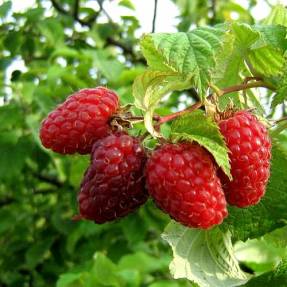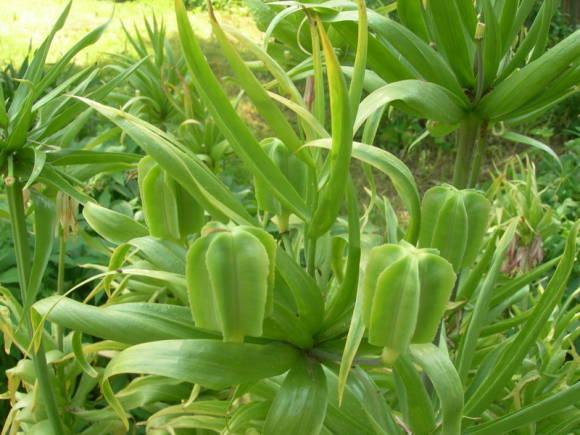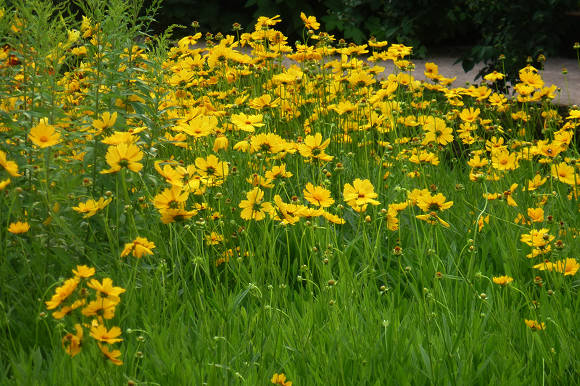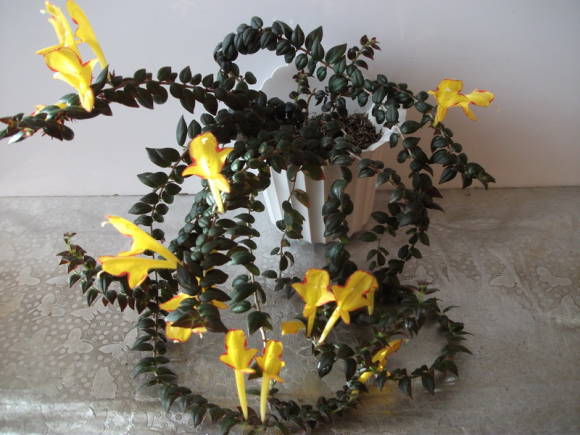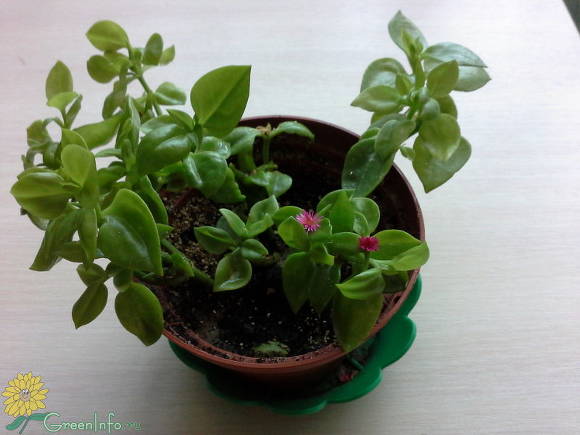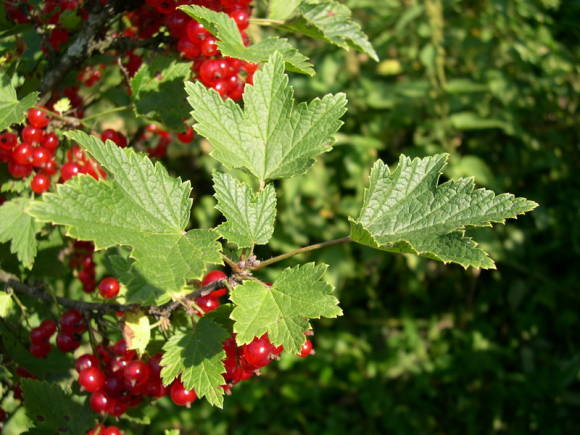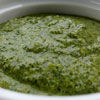If you consider a rose to be a flower of paradise, then you have not yet seen a rhododendron. Whoever meets him will begin to doubt whether the rose is really the queen of flowers. However, stop! I'm not going to push the fans of these two plants against each other. It just doesn't make sense. After all, rhododendrons bloom from April to June, and the first roses bloom no earlier than the end of June. Therefore, if their flowering and intersect, then only for a short moment of passing the baton.
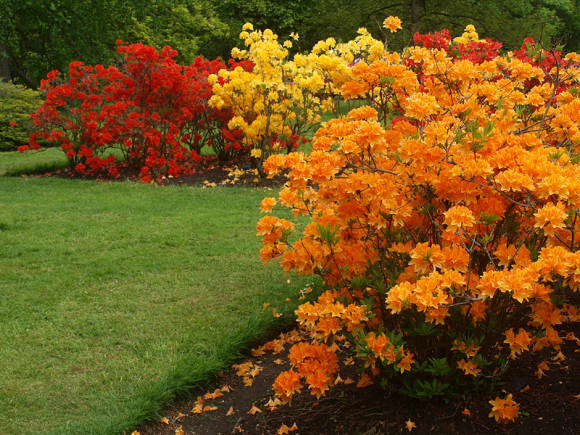 |
A new word in your vocabulary
The first thing I propose to start with is to learn how to make the correct stress in the very word rhododendron. For many it will be a surprise, but it should be done on a single letter "E", and not on the last "O", as most do. I myself unlearned wrong stress when I planted my first rhododendrons. It happened not so long ago, only in 2001. I remember that the seller, having heard my wrong "rhododendron", persistently corrected me. Since then - at least stir it up at night, and poke a seedling in the nose - what is it !? - I will mutter, albeit indistinctly, but with an emphasis in the middle: "Rhododendron!".
Over time, it began to seem to me that the stress on the "E" rhododendron is very good, it is somehow more respectable with it. Moreover, the correct stress is not an idle question. In general, you should try to do everything right with rhododendron. And then there will be no problem.
 |
Different, different - blue, red ...
Although the first experiments on the introduction of rhododendrons in Russia are associated with the end of the 18th century, a truly massive development of the bush has occurred since the beginning of this millennium. It is still in full swing. And I'm afraid it will be for a long time. There are several arguments for this. First, we first need to overcome the lag behind the leading European countries in this area. Secondly, Russia is large, and variety research should be specific. What is good for Kaliningrad is not good for Vladimir. And varieties suitable for Sochi are freezing in Krasnodar.
Rhododendrons are classified as deciduous, evergreen, and semi-evergreen. Semi-evergreens include species that behave in two ways - in a warm climate, their leaves practically do not fall; in cold weather, they shed most of the leaves, leaving them only at the top. In central Russia, you can grow cultivars of any of these groups.
I will share my, albeit small, but certainly useful for beginners, the experience of rhododendron culture. And as teaching aids, rhododendrons from our collection (we have a little more than 20 of them) and also those that are grown by our friends will act.
Rhododendron Vasey (Rhododendronvaseyi) - deciduous shrub, with an openwork spherical crown, in culture no more than 80-90 cm high. Originally from the state of North Carolina, USA. Fully winter-hardy, although flower buds are sensitive to spring return frosts. Because of this, it succeeds better where the soil thaws in spring and warms up later - on the northern slopes and where a lot of snow accumulates. The flowers are funnel-shaped, light pink with brownish-red dots. Blooms before the leaves open.
 |  |
Daurian rhododendron (Rhododendrondahuricum) - deciduous shrub, but sometimes some of the leaves at the top remain to winter on the plant. The usual height of the bush is about 70-90 cm. The leaves are ovate-elliptical, up to 6 × 2 cm. The flowers are lilac-pink, broadly funnel-shaped. It blooms in early spring, before the leaves open, about a crescent.
It grows well in ordinary garden soil, if you add high peat to it. In central Russia it is stable, but flower buds often suffer from thaws and return frosts. In nature, this species is widespread in the south of Eastern Siberia and the Far East. It is Siberians who most often call it "wild rosemary".
Rhododendron yellow (Rhododendronluteum) - deciduous spreading shrub with a usual height of 70-80 cm. It is found naturally in the Caucasus and the Carpathians.Undemanding to growing conditions, drought-resistant, winter-hardy, disease resistant. It grows well in full light, on ordinary slightly acidic and neutral soils with the addition of peat or heather soil. The flowers are golden-yellow, broadly bell-shaped, about 4 cm in diameter, with a pleasant aroma, collected in 8-15 pieces in rather dense irregular brushes. One of the first blooms in early May for 15-18 days.
 |
One of the most reliable rhododendrons. In terms of the sum of its qualities, it is included, if not in the top five, then in the top ten rhododendrons for central Russia. It tolerates the urban environment well, it is recommended not only for a private garden, but also for landscaping city courtyards and public places.
Caucasian rhododendron (Rhododendroncaucasicum)- evergreen, 50-70 cm high, leaves 5-7 cm long, leathery, glossy, pointed, concave along the midrib, which resembles the leaves of indoor ficuses. In culture, it is stable, unpretentious, can grow in the open sun and in light partial shade. It grows slowly, does not bloom earlier than 8-10 years. The flowers are broadly campanulate, creamy white with green specks. Thanks to its unusually attractive leaves, it is beautiful even in a non-flowering state. It goes well with stone and dwarf conifers: thujas, Konika gray spruce, mountain pine, hemlock, cypress ...
It remains to be regretted that this shrub is still rare in our front gardens. After all, as follows from the specific epithet, he is a native of the Caucasus, endemic. In the mountains, by the way, it grows at altitudes from 1500 to 3000 m, which determines its high winter hardiness.
Kamchatka rhododendron (Rhododendroncamtchaticum) - a small deciduous shrub up to 30 cm high.Leaves are obovate, sometimes almost round, dark green, ciliate along the edge, 2-5 cm long.Flowers 2.5-5 cm in diameter, wide open, reddish-lilac or pinkish, in inflorescences 1-3 pcs. Blooms in June-July for more than 20 days.
In nature, it is found along the seacoasts of the Far East from Japan in the south to Chukotka and Alaska in the north. Winter-hardy, hygrophilous, photophilous. Prefers moist but drained soils with a slightly acidic or neutral reaction. A number of botanists believe that this species is not a rhododendron, but should be attributed to a special genus. terorodion (Therorhodion), and therefore it is necessary to call it - Kamchatka Terorodion.
 |  |
Rhododendron canadian (Rhododendroncanadense) - deciduous shrub with a usual height of 60-70 cm. It blooms in early May, blooms for more than two weeks. Flowers 2-3 cm in diameter, pinkish-purple, light purple, white in inflorescences of 3-7 pcs. The petals are narrow, sticking out to the sides, which makes the flowers look somewhat disheveled. It blooms profusely and for a long time in early spring - more than three weeks.
His homeland is the east of North America from Pennsylvania to Quebec and Newfoundland. Already the very specific epithet of this species transparently hints at its resistance to frost. After all, Canada is very similar in climate to Russia. Indeed, it is fully adapted in central Russia. It should be noted that, unlike most rhododendrons, its natural habitats are not mountains, but the usual Canadian taiga, where it often settles in swampy forests and on sphagnum bogs with an admixture of spruce, fir, hemlock and pine.
Photophilous. In culture, it grows well on ordinary garden soils with the addition of peat.
Rhododendron ketevbinsky (Rhododendroncatawbiense) - evergreen shrub 90-150 cm high with a dense crown. Leaves are elliptical, glossy 4 × 9 (5 × 12) cm. The flowers are purple-lilac, 5-6 cm in diameter, collected in dense rounded inflorescences of 14-20 pcs. Blooms in late May for more than three weeks.
 |  |
This rhododendron, (meaning not only the natural form, but also numerous varieties) is the most represented in the gardens of Europeans. Although it has a subtropical origin (USA, Virginia, Carolina, Tennessee), its genome has a rare winter hardiness, which, apparently, is a consequence of its habit of settling in the highlands.Hybrid varieties of Ketevbinsky, bred in the countries of Scandinavia, show themselves especially adapted in our country.
Tolerates full sun, but intermittent partial shade is more favorable. It is reconciled with ordinary garden soil, well diluted with high-moor peat. But it grows better on a constantly moist substrate with the addition of large doses of heather soil.
Rhododendron sticky (Rhododendronviscosum)... Homeland - the east coasts of the Atlantic, USA. Sprawling, openwork deciduous shrub up to 150 cm high. It blooms in late May for more than two weeks. Flowers up to 4 cm in diameter, with narrow petals, arachnid, white or light pink.
Winter-hardy, sun-loving. Sensitive to air and soil moisture, poorly tolerates drought. Grows well on a substrate composed of peat, heather and sand 2: 1: 1.
Short-fruited rhododendron (Rhododendronbrachycarpum), according to modern classification - Rhododendron Fori (Rhododendron fauriei). Homeland - Korea, Japan, Iturup Island. Evergreen shrub 150-200 cm high, with a dense spherical crown. Bell-shaped flowers, creamy white with a slight pink tint, about 5 cm in diameter, in dense inflorescences of 10-18 pcs. The leaves are elliptical, large, leathery, up to 6 × 20 cm in size. Thanks to the luxurious evergreen leaves, this rhododendron is unusually beautiful even in the absence of flowers. Imagine lingonberry leaves enlarged 10-15 times!
 |  |
It is appropriate to mention here the characteristic property of evergreen rhododendrons to roll leaves into tubes in frost. The point to which this process is tied is the temperature + 4 ° C. Watching the leaves has become a habit for me. When I want to find out how it is on the street, I no longer look at the thermometer, but look out into the front garden. If the rhododendron leaves are rolled into tubes - you need to dress up warmly, if unfolded - it will come off in a leather jacket.
Rhododendron largest (Rhododendronmaximum) - in nature - a large evergreen shrub, sometimes a small tree. In culture, it is usually not higher than 2 m, and a little more in width. Originally from the east coast of the United States. Blooms relatively late - from early June, 15-18 days. The flowers are funnel-shaped, 4-5 cm in diameter, white or pink, in dense slightly disc-shaped inflorescences of 15-20 pieces. Tolerates full sun, but light partial shade is preferable. Sensitive to drought, the soil for it needs slightly acidic, permeable, but constantly moist.
It is interesting for its unusually large leathery leaves 5 × 15 (7 × 25) cm, thanks to which the shrub is attractive throughout the garden season.
Rhododendron sihotinsky (Rhododendronsichotense), according to the new classification, a subspecies of rhododedron spiky (Rhododendron mucronulatum ssp.sichotense) - semi-evergreen, grows in the garden as an openwork spreading bush, no more than 80-100 cm in height. The leaves are dark green, leathery, oval, no more than 3 × 2 cm in size. In winter, most of the leaves fall off, but the apical leaves remain on the bush, changing their color to chocolate brown. It blooms in early spring for 15-20 days. Shirokokolokolchatye flowers, up to 5 cm in diameter, lilac-pink, in brushes of 3-4 pieces.
Fully winter-hardy, but sensitive to winter thaws. Moderately photophilous, prefers slightly acidic, peaty soil.
 |  |
Rhododendron Schlippenbach (Rhododendronschlippenbachii) is a deciduous shrub with a usual height of 80-120 cm. It blooms in early spring for 3-4 weeks. Flowers 6-8 cm in diameter, wide open, white-pink, sometimes with a slight lilac tint. Thanks to its wide leaves and large flowers, it cannot be confused with another. It is rare in gardens, although it is considered one of the most beautiful deciduous species. It grows best on moist and acidic soil of light composition, prefers light partial shade.
Winter-hardy, unpretentious. However, it blooms unstably, because in the thaw, flower buds can wake up and then freeze. To avoid this, it is advisable to plant it in places where there is a lot of snow in winter, or to cover it with snow on purpose.
Japanese rhododendron (Rhododendronjaponiicum) - an openwork deciduous shrub with a height of 70-90 cm. Perhaps this is the rhododendron that a beginner should be the first to invite to his front garden. After all, in our middle lane, few people were disappointed in it. It tolerates the open sun, grows well in ordinary garden soil, blooms not only profusely, but every year, without interruption.
 |
For better development and more abundant flowering, it is advisable to refine the soil with peat and heather soil. Possible option: sod land, peat, heather land 1: 2: 1. For the northern regions, it can be recommended to plant it in places where a lot of snow accumulates, or to throw it on purposely. This will delay the development of the bush, and the flower buds will escape from recurrent frosts.
It so happened that the Japanese became the first rhododendron to bloom in our garden. He was so overwhelmed by his brightness that I "lost my nerves." The fact is that he grew up in a country garden, loomed from a distance with his orange "outfit", which caused curious questions. Fearing for its integrity, we moved the bush to the city's front garden. However, this was doubly correct, because in the new place it became a kind of enticing bait - "mormyshka", to which the buyer went en masse.
Japanese, I note, became the first rhododendron, the seedlings of which we have grown for sale. Convinced of its irresistible beauty and complete unpretentiousness, we do not hesitate to recommend it to everyone, without exception. And he does not fail!
Not difficulties, but agricultural technology
If the apple tree, cherry and plum are monotonous and understandable in their preferences, then it is impossible for a rhododendron to offer agricultural technology that would suit all species. They differ in the requirements for both illumination and soil composition. At the same time, they also have common features. For example, deciduous rhododendrons, as a rule, are more sun-loving, and evergreens do not like the sun or do not tolerate at all. The vast majority of rhododendrons prefer acidic (pH 4.0-5.5) soils with a significant organic component. At the same time, rhododendrons have a known plasticity, so the recommendations and formulations below are not strictly prescribed.
 |
Landing site.Illumination. The location requirements are primarily in the illumination. Most rhododendrons do not like completely open spaces or strong shade. A good option is to be among other shrubs - intermittent partial shade; or where plants are protected from the high sun "at the zenith". These are, for example, open places to the north of the buildings, where the sun is not present only at noon or two. As for deciduous rhododendrons, such as Vaseya, Japanese, yellow, they are so good that they do not "burn" even in the heat.
Another requirement for the landing site is protection from winds and the presence of snow cover. And this is understandable - the winds not only cool, but also dry up, which is especially dangerous for evergreen species. When the bush is completely covered with deep snow, it has everything it needs: constant moisture and protection from frost.
The soil.Top dressing. The soil must be constantly moist but permeable. To prepare the substrate, it is undesirable to use old garden soils, as they accumulate pathogenic fungi. Fresh forest soil, heather soil, and peat are highly desirable components of the soil mixture.
Although there is no universal substrate, most rhododendrons respond positively to the presence of high-moor peat. For the full well-being of plants, the soil must contain mycorrhiza - mushroom starter, which is found in the soil from the pine forest.
It is advisable to prepare the substrate based on natural ingredients. As a basis, take fresh, uncultivated soil. It is recommended to use as additional ingredients peat, heather land, coniferous litter.
Since the heather family, to which the rhododendron genus belongs, has very specific requirements for soil conditions, it is advisable to grow heathers separately from other plants. This will significantly reduce labor costs and facilitate maintenance. Here are just some of those who with great pleasure will share a place in the sun with rhododendrons: blueberries, cranberries, heather, wild rosemary, lingonberry, whitewash. There are also many plants, which, as experience shows, will not hesitate to keep them company: hydrangeas, wolf, ochik, saxifrage, irises, loosestrife, fescue, thuja, junipers, spruce, fir, hemlock and many others.
Watering. That's really, with what you can not overdo it! After all, rhododendrons for the most part come from places with high air and soil humidity: sea coasts and regions with a monsoon climate, mountain valleys with an abundance of streams, etc. For irrigation, it is advisable to use rainwater, and to carry it out by sprinkling. It is better to water in small doses, but more often.
Where to buy a seedling. It should be noted that one of the reasons for failures with rhododendrons is the quality of the planting material. And this should be talked about without hesitation, without bluntness. In shopping centers, planting material is most often sold, produced in Holland, Belgium, Denmark and other countries with a favorable climate. Of course, it cannot be adapted to our climate just because it does not know what Russian winter is. To acclimatize, the rhododendron must go through several screening sieves. To live under our sun for at least a dozen years, go through the full cycle of its development: bloom repeatedly, and give well-ripened, viable seeds. But already his offspring - seedlings of the first and subsequent generations, can be considered fully adapted to our climate.
 |
I was lucky that the first rhododendrons were purchased by me from a compatriot. He was an employee of the botanical garden, and fully adapted rhododendrons from the GBS collection acted as mother plants. That is, plants that have bloomed for a long time. Seed rhododendrons from local testes, I note - the most reliable planting material. And the fact that they do not exactly repeat the parental shape should not hold you back. Endurance is in the foreground. By the way, despite the splitting of signs, seedlings of rhododendrons are almost never inferior in decorativeness to their parent.
We have started growing rhododendrons in our nursery quite recently - since 2011. Now the range of our products is still small. But these are reliable adapted seedlings from their own, several years of flowering, testes. By the way, a serious producer of rhododendron seedlings cannot grow with a navel out of the blue. After all, this is not a quick matter. And the one who arose out of nothing, and immediately with an assortment of dozens of varieties, is clearly a reseller. So choose wisely and be vigilant!
Into your dictionary
Horse peat. High bog peat formed on the basis of sphagnum mosses. Has a high moisture capacity and acidic reaction, pH 3.5-4.0. An essential component of the soil substrate for most rhododendrons. Usually has a reddish color and fibrous structure.
Heather land - the upper layer of forest litter, 10-20 cm thick, including part of the bedrock, from an old pine or spruce forest, in the lower layer of which species such as lingonberry, heather, wild rosemary, bilberry, cranberry, blueberry, etc. grow. It is useful to add heather soil under all heather rhododendrons little by little, but constantly, thus imitating the process of fertilizing heathers in nature with coniferous litter. Heather soil has an acidic reaction, is rich in organic matter and is inhabited by mycorrhiza of useful fungi, usually protozoa.
Leaf land - the upper, the most organic-rich part of the soil from the old forest, in the stand of which such species as linden, oak, maple, alder, and aspen prevail.
Coniferous litter - the upper, organic component of the heather land, including completely decomposed and recently fallen needles, as well as bark particles.Coniferous litter loosens and acidifies the soil.
Mycorrhiza - mutually beneficial cohabitation (symbiosis) of fungal mycelium with the roots of trees, shrubs and herbs. All plants of the heather family, including rhododendrons, need the presence of symbiotic fungi in the soil. It is not difficult to add mycorrhiza sourdough with heather soil, and it is advisable to stimulate its development by systematic addition of coniferous litter.
Have a conscience! Return the plant to its rightful owner!
And now, at the end of the day. Although our collection already includes more than 20 cultivars, I dream of bringing it to fifty. This is not at all a fantasy, because the world assortment of rhododendrons numbers tens of thousands of varieties. But here's the annoyance, we still do not have one of the most beautiful evergreen species - Smirnov's rhododendron. And so I want to be.
Rhododendron Smirnov (Rhododendronsmirnowii) - an evergreen shrub up to 120 cm high with a dense spherical or cushion-shaped crown. Leaves are glossy, broadly or elliptical, 9 × 3 (4 × 12) cm, ferruginous brown inside. Lives in the Transcaucasia in the mountains at altitudes up to 2500 m. Flowers 5-6 cm in diameter, bell-shaped, bright, beautiful. Unusually pleasant garnet pink color. It is winter-hardy, sun-loving, rather unpretentious to soil conditions, easy to cultivate.
 |
This species, by the way, is named after my namesake, Russian doctor and great plant lover Mikhail Smirnov. And in our family there is a narrowly corporate joke on this score - they say, the specific epithet of Smirnov is not an epithet at all, but a sign of belonging to Smirnov. That is to us. That is me!
- Whose rhododendron ?! - Smirnova!
- Well, give it back! I promise you nothing will happen! And after all - what they are doing - just some kind of chaos! Everyone knows - whose, and keep quiet! Hey! Be human! Give it back! After all, this is a gross violation of the rights of the owner!
By the way, we will be happy to exchange with those who offer us this, or other rhododendrons that we do not have.
Plants for the garden by mail. Shipping experience in Russia since 1995.
Catalog in your envelope, by e-mail or on the website.
600028, Vladimir, 24 passage, 12
Smirnov Alexander Dmitrievich
E-mail: [email protected]
Tel. 8 (909) 273-78-63
Online store on the site www.vladgarden.ru
